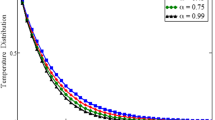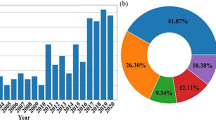Abstract
This paper analyses the numerical difficulties commonly encountered in solving fully coupled numerical models and proposes a numerical strategy apt to overcome them. The proposed procedure is based on space refinement and time adaptivity. The latter, which in mainly studied here, is based on the use of a finite element approach in the space domain and a Discontinuous Galerkin approximation within each time span. Error measures are defined for the jump of the solution at each time station. These constitute the parameters allowing for the time adaptivity. Some care is however, needed for a useful definition of the jump measures. Numerical tests are presented firstly to demonstrate the advantages and shortcomings of the method over the more traditional use of finite differences in time, then to assess the efficiency of the proposed procedure for adapting the time step. The proposed method reveals its efficiency and simplicity to adapt the time step in the solution of coupled field problems.
Similar content being viewed by others
References
Garagash D, Detournay E (2000) The tip region of a fluid-driven fracture in an elastic medium. J Appl Mech 67: 183–192
Chen Z, Steeb H, Diebels S (2006) A time-discontinuous Galerkin method for the dynamical analysis of porous media. Int J Numer Anal Methods Geomech 30: 1113–1134
Kuhl D, Meschke G (2007) Numerical analysis of dissolution processes in cementitious materials using discontinuous and continuous Galerkin time integration schemes. Int J Numer Methods Eng 69: 1775–1803
Lewis RW, Schrefler BA (1998) The finite element method in the static and dynamic deformation and consolidation of porous media. Wiley, New York
Margolin LG (1984) A generalized Griffith criterion for crack propagation. Eng Fract Mech 19: 539–543
Dienes JK (1986) Comments on a generalized Griffith criteria for crack propagation. Eng Frac Mech 23: 615–617
Hilleborg A, Modeer M, Petersson PE (1976) Analysis of crack formation and crack growth in concrete by means of fracture mechanics and finite elements. Cement Concrete Res 6: 773–782
Witherspoon PA, Wang JSY, Iwai K, Gale JE (1980) Validity of cubic law for fluid flow in a deformable rock fracture. Water Resour Res 16: 1016–1024
Boone TJ, Ingraffea AR (1990) A numerical procedure for simulation of hydraulically driven fracture propagation in poroelastic media. Int J Numer Anal Methods Geomech 14: 27–47
Camacho GT, Ortiz M (1996) Computational modelling of impact damage in brittle materials. Int J Solids Struct 33: 2899–2938
Schrefler BA, Secchi S, Simoni L (2006) On adaptive refinement techniques in multi-field problems including cohesive fractures. Comput Methods Appl Mech Eng 195: 444–461
Secchi S, Simoni L, Schrefler BA (2007) Numerical procedure for discrete fracture propagation in porous materials. Int J Numer Anal Methods Geomech 31: 109–370
Secchi S, Simoni L (2003) An improved procedure for 2-D unstructured Delaunay mesh generation. Adv Eng Softw 34: 217–234
Zhu JZ, Zienkiewicz OC (1998) Adaptive techniques in the finite element method. Commun Appl Numer Methods 4: 197–204
Zhou F, Molinari JF (2004) Dynamic crack propagation with cohesive elements: a methodology to address mesh dependency. Int J Numer Methods Eng 59: 1–24
Falk ML, Needleman A, Rice JR (2001) A critical evaluation of cohesive zone models of dynamic fracture. J Phys IV 11: 43–50
Barenblatt GI (1959) The formation of equilibrium cracks during brittle fracture: general ideas and hypotheses. Axially-symmetric cracks. J Appl Math Mech 23: 622–636
Secchi S, Simoni L, Schrefler BA (2004) Cohesive fracture growth in a thermoelastic bi-material medium. Comput Struct 82: 1875–1887
Li XD, Wiberg NE (1996) Structural dynamic analysis by a time-discontinous Galerkin finite element method. Int J Numer Methods Eng 39: 2131–2152
Zhang M, Shu C-W (2003) An analysis of three different formulations of the discontinuous Galerkin method for diffusion equations. Math Models Methods Appl Sci 13: 395–413
Kuhl D, Bangert F, Meschke G (2004) Coupled chemo-mechanical deterioration of cementitious materials Part II: Numerical methods and simulations. Int J Solids Struct 41: 41–67
Author information
Authors and Affiliations
Corresponding authors
Rights and permissions
About this article
Cite this article
Simoni, L., Secchi, S. & Schrefler, B.A. Numerical difficulties and computational procedures for thermo-hydro-mechanical coupled problems of saturated porous media. Comput Mech 43, 179–189 (2008). https://doi.org/10.1007/s00466-008-0302-2
Received:
Accepted:
Published:
Issue Date:
DOI: https://doi.org/10.1007/s00466-008-0302-2




